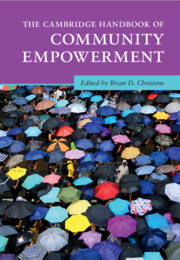Book contents
- The Cambridge Handbook of Community Empowerment
- Cambridge Handbooks in Psychology
- The Cambridge Handbook of Community Empowerment
- Copyright page
- Contents
- Figures
- Tables
- Contributors
- Building Community Power
- Part I Organizing and Activism
- Part II Participatory Governance
- Part III Civil Society and Coalitions
- 11 Community Leadership Development
- 12 Community Coalitions and Empowerment
- 13 Youth-Infused Community Coalitions
- 14 Neighborhood Associations and Community Change
- 15 State-Led Community (Dis)empowerment in China
- Part IV Enterprise
- Part V Participatory and Community Arts
- Part VI Education and Engaged Research
- Contributor Details
- Index
- References
13 - Youth-Infused Community Coalitions
from Part III - Civil Society and Coalitions
Published online by Cambridge University Press: 18 April 2024
- The Cambridge Handbook of Community Empowerment
- Cambridge Handbooks in Psychology
- The Cambridge Handbook of Community Empowerment
- Copyright page
- Contents
- Figures
- Tables
- Contributors
- Building Community Power
- Part I Organizing and Activism
- Part II Participatory Governance
- Part III Civil Society and Coalitions
- 11 Community Leadership Development
- 12 Community Coalitions and Empowerment
- 13 Youth-Infused Community Coalitions
- 14 Neighborhood Associations and Community Change
- 15 State-Led Community (Dis)empowerment in China
- Part IV Enterprise
- Part V Participatory and Community Arts
- Part VI Education and Engaged Research
- Contributor Details
- Index
- References
Summary
Youth-infused community coalitions engage youth and adults in addressing complex issues at the local level. Coalitions tend to engage young people when the issues they address pertain to the youth population in their community. This chapter provides an example of a youth-infused community coalition located in Appalachian Ohio that seeks to promote the health and well-being of community members. Youth engage directly with adults on the coalition to review data, identify root causes of problems in their community, and implement strategies to address these issues. We detail how participating in youth-infused community coalitions facilitates the growth and development of youth and their communities and then identify three features critical to facilitating community power and psychological empowerment in youth-infused community coalitions: member representation, decision-making processes, and opportunity role structure.
Keywords
- Type
- Chapter
- Information
- The Cambridge Handbook of Community Empowerment , pp. 337 - 359Publisher: Cambridge University PressPrint publication year: 2024

